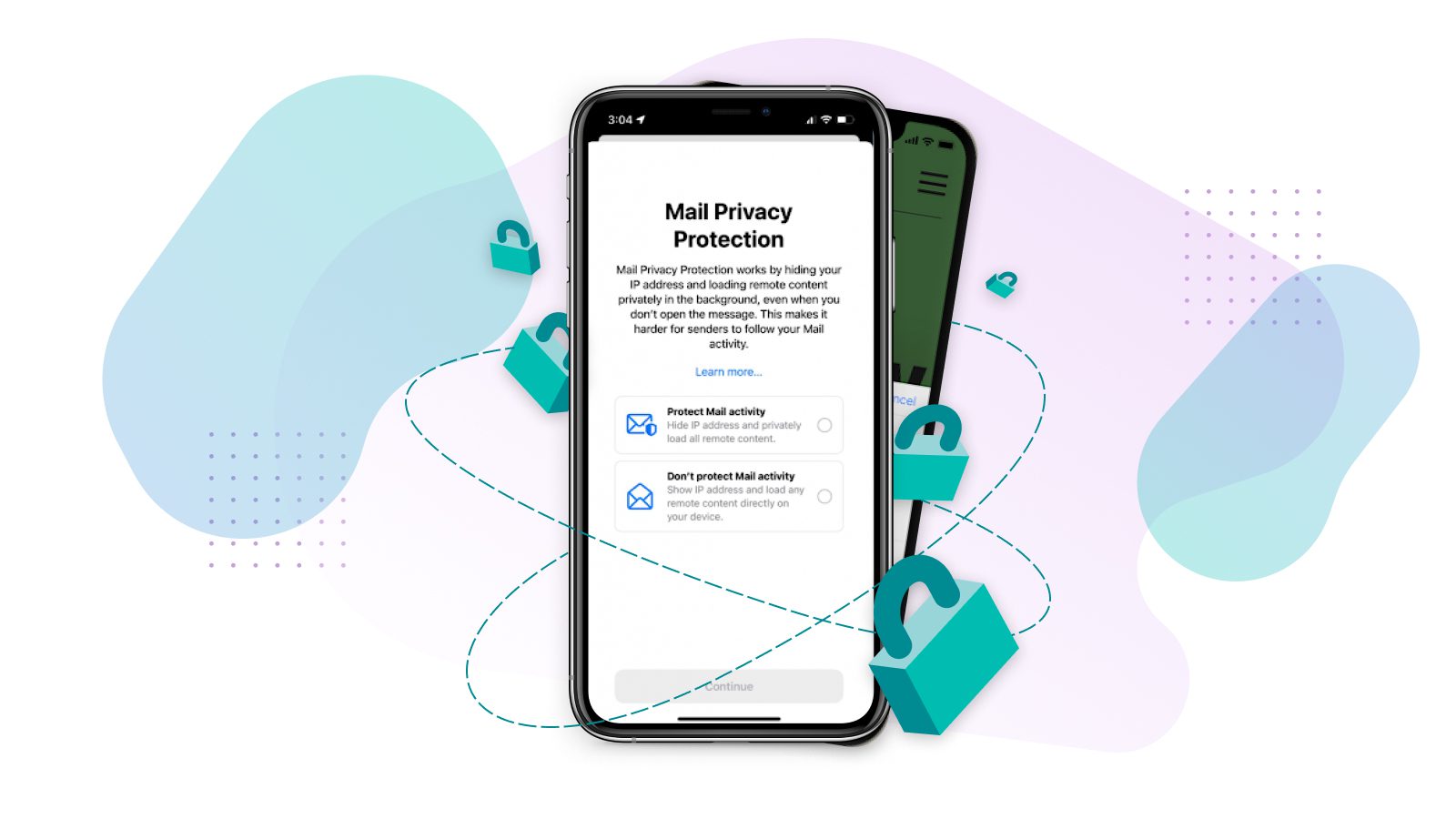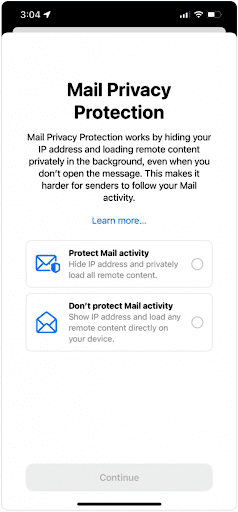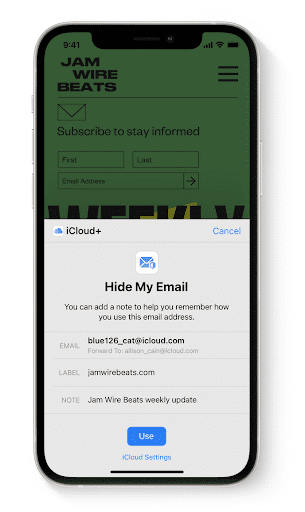In June of 2021, Apple dropped a bomb on the email community — their new mail privacy protection (MPP) update.
This update changes the email marketing industry forever.
And it impacts the reliability of a favorite metric — the open rate.
The update is now live in iOS 15.
Are the changes a win for email users?
Or the death of the email open rate and a serious blow to marketers?
In this article, I’ll explore these questions, and share nine steps for marketers to adapt and thrive — despite the changes.
But first, a little context. What is changing?
What is Apple’s new Mail Privacy Protection update?
Apple is giving their email users more control over their privacy.
After installing the iOS 15 update, users will see a message prompting them to choose their Mail Privacy Protection settings. They can choose to either protect their mail activity or not.
For any users who choose to protect their mail activity, marketers won’t be able to accurately track certain aspects of their email activity — like open rates for example.
This will impact any emails opened from the Apple Mail app on any device. Which, according to Litmus, accounts for 49.8% of all email opens.
So the impact is massive. “We expect 95% or more of Apple Mail users who upgrade to the new operating systems to enable Mail Privacy Protection,” says Chad S. White, Head of Research at Oracle Marketing Consulting and author of Email Marketing Rules. “That level of adoption would also match up with the 96% of Apple users who opted out of app tracking in the United States, according to Flurry Analytics.”
White goes on to explain that how Apple presents this choice scares users and sways them to adopt the privacy measures.
“That’s based in part on how biased the opt-in language is, which presents it as a choice to ‘Protect Mail privacy’ or ‘Don’t protect Mail privacy.’ Apple then goes on to refer to tracking pixels as loading ‘remote content directly on your device,’ which makes it sound like marketers are distributing malware instead of trying to determine if their subscribers are engaging with their messages.”
While Apple presents this choice in a way that makes it feel like a no-brainer to adopt the higher security measures, there are actually downsides to the user — like less personalized email content (more on this later on).
Apple’s updates also include a new option called Hide My Email.
Hide My Email allows users to camouflage their email addresses when they subscribe to a newsletter or sign up for an app. It generates a unique, random email address that automatically forwards to your personal inbox.
The best part? Only the app or website you signed up with can use this random email address to communicate with you. That way, users get the benefit of wanted emails without actually giving away their true email address.
This feature is a huge win for consumers. Many businesses have the nasty habit of selling email addresses. This will make it impossible to do that. Meanwhile, it allows marketers to continue to send wanted emails to subscribers.
Why is Apple launching these privacy features?
Consumers want more privacy. Apple is delivering on that wish.
After years of marketers and businesses abusing email marketing and selling personal information, it’s little wonder consumers are sick of it. And unsurprisingly, they want more protection.
Ethical marketers should want this too. What’s good for consumers is good for us. When consumers are confident their information is secure and safe, they’re more likely to trust us. They’re more likely to subscribe and stay on our lists.
However, the question is whether or not these updates are actually good for consumers. And what impact they have on marketers.
Are open rates dead now?
Yes and no.
To understand this, we need to take a step back and see how email platforms track open rates. Email providers (like Apple Mail) don’t actually share open rate information with email marketing platforms (like Sendgrid or MailChimp).
So email platforms found a roundabout way to track open rates. They insert a tiny, invisible image in every marketing email. When that image loads, the email platform tracks it as an open.
In the past, email service providers (ESPs) loaded images when a user opened an email. (And consequently, ESPs tracked an open.)
That’s where Apple is changing things. Now, Apple Mail will pre-load every image themselves (via a proxy server). As a result, email marketing platforms will think Apple Mail emails have been opened by the subscriber and track it as an open — even when the subscriber never opens. Which means marketers will see inflated open rates.
This makes the open rate metric pretty useless — at least for anyone on your list using Apple Mail.
But here’s what many people don’t know. Open rates have been inaccurate for years, and they’ve become increasingly inaccurate over time.
Many email users set their inbox preferences so that emails don’t load images by default. For these users, opens are never tracked — even when the user is consistently opening emails.
On top of that, email providers have already been pre-loading email images. “We’ve known for a while that other providers (Yahoo has said they’re doing it and my personal belief is that Google may be doing this as well) are pre-fetching images for some emails — just like Apple says they’re going to do,” writes Laura Atkins, Founder of Word to the Wise and email deliverability expert. “There are too many image loads that have zero to do with whether or not anyone actually opened an email.”
Again, these image loads by email providers make open rates inaccurate. While Apple’s email privacy update makes open rates more inaccurate, they were already inaccurate in the first place.
So marketers are panicking for no reason?
Not exactly.
Apple Mail dominates a large portion of the email market. With their update, open rates become completely inaccurate for this large percentage (49.8%) of email openers. While open rates have always been slightly inaccurate, now they may be drastically wrong.
Which creates some issues for email marketers. “Yes, email opens are a vanity metric when it comes to measuring email performance,” writes White on Twitter. “But opens are central to maintaining good list health and good deliverability given the incredible weight that mailbox providers give opens in their spam filtering algorithms.”
It also puts a wrench in email list cleaning. In the past, marketers cleaned their email lists by pulling a segment of subscribers who haven’t opened an email for a period of time. Then, they could send those disengaged subscribers a re-engagement email campaign.
Now, email marketers won’t be able to build an accurate segment of subscribers who haven’t opened emails.
What else is impacted besides open rates?
Most experienced email marketers agree businesses spend too much time worrying about open rates. They are not the most important email marketing metric.
With Apple’s update, the open rate fanaticism continues. Most worry only about the death of the open rate. But this update actually impacts quite a few other things as well:
- Click-to-open rate. Click-to-open rate is the percentage of people who clicked a link within an email after opening it. Historically, it’s been a great metric to track how engaging your email content is. Apple’s update makes it inaccurate for Apple Mail users.
- Forward tracking. Apple won’t allow you to track if a subscriber forwarded your message to another person.
- Send time optimization. Some email platforms offer send time optimization (STO). STO will track when a subscriber typically opens emails and send future emails at the times the subscriber is historically most likely to open. Since Apple will now be loading email images for subscribers, open times won’t be accurate and STO likely won’t work. That is, until email platforms base STO on something other than open time.
- Device type. You won’t be able to see what type of device Apple Mail users are opening your emails on.
- Location. You’ll no longer be able to see the IP address of Apple Mail users. Instead, you’ll be able to see the region their device is in. (This way, you can still track needed location information — like if someone is in Europe and under the protection of the GDPR, for example.)
- Live email content. Live email content — like countdown timers — load when an email is opened and images are loaded (not when an email is sent). So these live email elements will now be inaccurate.
These are major losses and limitations for many email marketers. Which explains why the email community has been panicking and preparing for months.
But it’s good for email users and consumers, right?
Maybe. Among email pros, there’s a lot of debate on this one.
While it’s intended to improve privacy and the email experience for consumers, it may actually hurt their experience.
Marketers often segment and personalize email content based on whether or not a subscriber opens. Personalization like this improves the email experience for subscribers. They receive more relevant email content as a result.
Subscribers actually appreciate and want this personalization. According to accenture, 83% of consumers are willing to share their data to create a more personalized experience.
Now, Apple Mail users won’t get accurate personalization or segmentation based on their email open activity. For example, brands often send more frequent emails to subscribers who open their emails. Meanwhile, they might stop sending to disengaged subscribers.
This is great for both types of subscribers, as they get more email content they like and less content they dislike. Now, this kind of personalization won’t be possible.
AWeber’s CEO Tom Kulzer brought up another point. Open rate data isn’t disappearing. Instead, who controls and sees the data is changing. Instead of marketers and email platforms seeing open rate data, Apple will now have it.
This places a lot of information and power in the hands of one company, instead of in the hands of many. Which means we must trust Apple to use the data responsibly. It’s likely they will, but it is possible they won’t.
9 steps to adapt your email marketing strategy
Whether or not it’s good for consumers, what can marketers do to adapt to Apple’s Mail Privacy Protection update?
Here’s a nine-step plan:
1. Use open rate benchmarks.
While we may no longer get a precise, completely accurate open rate, open rates will still be accurate for a percentage of our subscribers and can consequently increase or decrease based on the strength of our email marketing strategies. They’re still a good metric to watch.
However, instead of looking at the open rate of one email, marketers should look at trends and benchmarks. Ask yourself: “How have my emails performed, historically?” and “What trends can I identify and capitalize on?”
“We don’t need super accurate open rates,” says Andy Crestodina, Co-founder of Orbit Media. “Metrics only need to be accurate enough to help us make good marketing decisions. What is our benchmark based on historic data? Can we beat that benchmark next time? That’s the real question. Marketers who seek ever more accurate metrics will always be frustrated. Marketers who use the available data to make better decisions will see ever better results.”
2. Audit your email automation for open triggers.
Open triggers, which marketers can set up to send emails automatically based on who opens and doesn’t open an email, will no longer work correctly on a consistent basis.
You should audit where and when you use open triggers to understand the impact of this. You may also want to consider pivoting to a different trigger type, like clicks.
3. Determine A/B subject line test winners by total clicks.
While some have argued Apple’s privacy update kills subject line A/B testing, that’s not true. You can still A/B test your email subject lines.
Instead of choosing a winner based on which subject line gets more opens, choose based on which email gets more clicks. Simple!
4. Focus on more important metrics.
Email marketers have long called email open rates a vanity metric. There are other more essential metrics marketers can now shift their focus to, like:
- Clicks
- Conversions
- Unsubscribes
- Spam complaints
- Subscriber lifetime value
- Return on investment (ROI)
These metrics — especially ROI — have a greater impact on your bottom line than open rates anyway.
“It’s really too early to say how this will affect the email world in the long run. There is one clear positive, though: If you’re sending emails, these changes should inspire you to have a real conversation with your team about how you measure success,” says Dan Oshinsky, Founder and Consultant at Inbox Collective. “This is the perfect time to reevaluate which metrics you monitor, and possibly to choose new metrics you’ll want to use going forward.”
5. Use clicks to determine subscriber engagement.
When it comes time to clean your email list, you can no longer build a segment of people who haven’t opened recently and send them a re-engagement campaign. The segment won’t be accurate.
Instead, build a segment of subscribers who haven’t clicked on an email link in the last three-to-six months and send a re-engagement campaign to those subscribers.
6. Encourage subscribers to click.
Since clicks are now one of the primary ways to determine if a subscriber is engaged or not, you should work even harder to encourage subscribers to click.
“Don’t trick subscribers into clicking. Think creatively about how you can increase value, and you can increase clicks,” says Matthew Smith, Co-Founder of Really Good Emails.
“If you can understand what is frustrating for your customers, and solve that problem for them, your emails are instantly interesting and your copy is authentically convincing. Try things like asking subscribers to rate the value of your email for them. Show that you’re listening. There’s your click.”
7. Determine whether to continue using STO — if it’s based on opens.
Unfortunately, if send time optimization (STO) is based on when an email is opened, it’s not very reliable or accurate anymore.
You may want to turn off this functionality — unless (or until) your email platform finds a new way to determine when subscribers are opening or adjusts STO to be based off a measurable metric, like clicks.
8. Use AMP for Email for live content.
Apple’s update makes it difficult to use live email content in Apple Mail. However, Gmail allows live content via AMP for Email. “This change by Apple makes AMP for Email more attractive than it has been, since non-AMP-powered live content now works in fewer inboxes,” writes White.
(Not familiar with the term? Check out this white paper for everything you need to know about AMP for Email.)
9. Ask subscribers to share more info about themselves.
While you can no longer get IP address info from Apple Mail users automatically, you can still ask them to willingly share it.
Consider adding an email to your onboarding series which asks subscribers to share more info about themselves — like IP address, location information, and their preferred time to receive emails.
You can then personalize your messages based on the information they provide. Be sure to explain the benefit to your subscriber when you make your ask.
Email isn’t dead. Static marketing strategies are.
This isn’t the end of email marketing — far from it. Consumers love email (four billion+ people use it), and it’s here to stay.
We just need to adapt. Email marketing has changed significantly over its 30-year history. Marketers have — and will continue to — change with it.
It’s the marketers who adapt that will succeed in the end.


